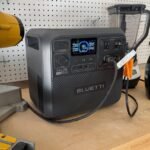Disclosure: This post contains affiliate links and I will be compensated if you make a purchase after clicking through my links. Learn More
To test a generator, start by checking the fuel levels and battery. Next, perform a load test to ensure proper functionality.
Generators are essential for backup power during outages. Regular testing ensures they work efficiently when needed. Testing a generator involves several steps that verify its performance and reliability. Begin by inspecting the fuel levels and battery condition. These basic checks prevent common operational issues.
Next, perform a load test. This simulates real-world usage and confirms the generator can handle the required power load. Regular maintenance, including oil changes and filter replacements, is crucial. Documenting each test helps track performance over time. By following these steps, you ensure your generator remains reliable and ready for emergencies.

Basic Components
Understanding the basic components of a generator helps in testing it effectively. Knowing each part’s function ensures accurate tests and safe operation.
Generator Parts
Generators have several key parts. These include:
- Engine: The power source of the generator.
- Alternator: Converts mechanical energy to electrical energy.
- Fuel System: Supplies fuel to the engine.
- Voltage Regulator: Controls the output voltage.
- Cooling System: Prevents the generator from overheating.
- Lubrication System: Reduces friction and wear in the engine.
- Exhaust System: Manages engine emissions.
- Battery Charger: Keeps the battery charged.
- Control Panel: The interface for operating the generator.
Choosing The Right Tools
Testing a generator requires the right tools. Using the correct equipment ensures accurate results and safety. This section will guide you on the essential equipment and safety gear needed for testing a generator.
Essential Equipment
Before you start testing, gather all necessary tools. Here is a list of essential equipment:
- Multimeter: Measures voltage, current, and resistance.
- Load Bank: Simulates the electrical load on the generator.
- Fuel: Ensure you have enough fuel for the test.
- Oil: Check and top up the oil level.
- Coolant: Make sure the coolant is at the right level.
Using these tools helps you check the generator’s performance accurately. Always double-check your tools before starting the test.
Safety Gear
Safety is crucial when testing a generator. Wear the right safety gear to protect yourself. Here’s what you need:
- Safety Glasses: Protect your eyes from debris and sparks.
- Gloves: Insulated gloves protect your hands from electrical shocks.
- Ear Protection: Reduce noise levels to protect your hearing.
- Fire Extinguisher: Keep one nearby in case of emergencies.
Wearing safety gear minimizes risks and ensures a safe testing environment. Always prioritize safety to avoid accidents.

Preparing The Generator
Before you test a generator, preparation is key. Proper preparation ensures safety and efficiency. This section guides you through the necessary steps.
Initial Inspection
Begin with a thorough initial inspection of your generator. Look for any visible damage.
- Check the exterior for dents and cracks.
- Inspect the control panel for any broken switches.
- Ensure all cables are intact and securely connected.
A detailed visual check prevents potential hazards. Always address any issues found during this step.
Fuel And Oil Check
Next, focus on the fuel and oil check. Both are crucial for the generator’s operation.
| Aspect | What to Check |
|---|---|
| Fuel Level | Ensure the tank is filled with the correct fuel type. |
| Fuel Quality | Check for contaminants like water or debris. |
| Oil Level | Use the dipstick to check the oil level. |
| Oil Quality | Ensure the oil is clean and free from particles. |
Maintaining proper fuel and oil levels is vital. This ensures your generator runs smoothly during tests.
Conducting A Load Test
Testing a generator ensures it works during power outages. Conducting a load test is crucial. This test simulates real-world usage. It ensures your generator can handle the expected load.
Setting Up The Load
First, gather necessary equipment. You need a load bank, cables, and a multimeter. Ensure the generator is in a well-ventilated area.
- Connect the load bank to the generator.
- Ensure all connections are secure.
- Start the generator and let it warm up for 5 minutes.
Gradually increase the load. Start with 25% of the generator’s capacity. Increase to 50%, then 75%, and finally 100%. This process ensures the generator handles varying loads.
Monitoring Performance
During the load test, monitor the generator’s performance. Use a multimeter to check voltage and frequency. Record the readings for each load level. Observe the generator’s response to each increase in load.
| Load Level | Voltage | Frequency |
|---|---|---|
| 25% | Record Voltage | Record Frequency |
| 50% | Record Voltage | Record Frequency |
| 75% | Record Voltage | Record Frequency |
| 100% | Record Voltage | Record Frequency |
Check for unusual noises or vibrations. Ensure the generator runs smoothly under each load.
After the test, gradually reduce the load. Let the generator run at no load for 5 minutes. This cools down the engine.

Checking Voltage Output
Testing a generator ensures it works correctly. One vital step is checking the voltage output. Correct voltage ensures your devices run safely. Let’s explore how to check this using a multimeter and understand the results.
Using A Multimeter
A multimeter measures electrical properties like voltage, current, and resistance. Here’s how to use it:
- Turn off the generator.
- Set the multimeter to measure AC voltage.
- Connect the black lead to the generator’s ground terminal.
- Connect the red lead to the generator’s output terminal.
- Turn on the generator.
- Read the voltage on the multimeter display.
Ensure you follow these steps carefully to avoid errors.
Interpreting Results
The multimeter shows the generator’s voltage output. Compare this reading to the generator’s rated voltage.
| Reading | Interpretation |
|---|---|
| Matches rated voltage | The generator is working correctly. |
| Higher than rated voltage | There may be a regulation issue. |
| Lower than rated voltage | The generator might need maintenance. |
Understanding these results helps keep your generator in top shape.
Inspecting Electrical Connections
Testing a generator is essential for ensuring its functionality. One critical aspect is inspecting electrical connections. This step ensures your generator operates safely and efficiently. Faulty connections can lead to serious issues, including fire hazards and equipment failure.
Cable Integrity
First, check the cable integrity. Look for any signs of wear or damage. Damaged cables can cause short circuits and inefficiencies.
- Examine the outer insulation for cracks or cuts.
- Check for any exposed wires.
- Ensure that the cables are not tangled or twisted.
Using a multimeter, test the cables for continuity. This helps confirm they are conducting electricity properly. If you find any damaged cables, replace them immediately.
Connection Tightness
Next, verify the connection tightness. Loose connections can cause erratic generator performance.
- Use a wrench to tighten all the bolts and nuts.
- Check the terminals for secure attachment.
- Ensure there is no corrosion on the connections.
Corroded connections can be cleaned using a wire brush. Always wear safety gloves while performing this task. After cleaning, apply a thin layer of dielectric grease to prevent future corrosion.
| Inspection Step | Action Required |
|---|---|
| Cable Integrity | Check for damage, test with a multimeter |
| Connection Tightness | Tighten bolts and nuts, clean corrosion |
Ensuring the integrity and tightness of electrical connections keeps your generator running smoothly. Regular inspections can prevent potential issues and prolong the generator’s life.
Evaluating Exhaust System
Testing a generator involves several critical steps. Evaluating the exhaust system is one of them. A well-maintained exhaust system ensures the generator runs safely and efficiently. This section focuses on visual inspections and noise levels.
Visual Inspection
Start with a visual inspection of the exhaust system. Look for any visible damage or wear.
- Check for cracks or holes in the exhaust pipes.
- Ensure there are no loose or missing bolts.
- Inspect the muffler for any signs of rust or corrosion.
A damaged exhaust system can lead to dangerous fumes. It can also reduce the generator’s efficiency.
Noise Levels
Noise levels can indicate the health of the exhaust system. A louder than usual generator may have exhaust issues.
- Start the generator and listen to the exhaust sound.
- Compare the noise levels to the manufacturer’s specifications.
- Note any unusual sounds like popping or hissing.
High noise levels often suggest exhaust leaks or muffler problems. Fixing these issues can improve the generator’s performance.
Regular checks and maintenance can keep the exhaust system in top shape. This ensures your generator runs safely and efficiently.
Testing Safety Features
Ensuring the safety features of a generator are functioning properly is crucial. These features protect you from accidents and the generator from damage. This section will guide you through testing the two main safety features: Automatic Shutoff and Overload Protection.
Automatic Shutoff
The automatic shutoff feature is essential for preventing overheating and other issues. Here’s how to test it:
- Start the generator and let it run.
- Simulate a fault condition, like low oil or high temperature.
- Check if the generator shuts down automatically.
If the generator doesn’t shut off, the automatic shutoff feature might be faulty. In this case, consult the user manual or a professional technician.
Overload Protection
Overload protection safeguards the generator from being damaged by excessive load. Follow these steps to test it:
- Connect appliances that exceed the generator’s capacity.
- Monitor the generator’s response.
- Ensure the generator stops supplying power when overloaded.
If the generator continues to supply power, the overload protection may not be working. This can be dangerous and should be addressed immediately.
| Safety Feature | Purpose | Testing Method |
|---|---|---|
| Automatic Shutoff | Prevents overheating and other issues | Simulate a fault condition and check if it shuts down |
| Overload Protection | Prevents damage from excessive load | Connect appliances over capacity and observe response |
Testing these safety features regularly ensures your generator runs safely. Always refer to the user manual for specific instructions.
Maintaining Your Generator
Keeping your generator in top shape is essential. Regular maintenance ensures it runs efficiently. Follow these simple steps to keep it functioning well.
Routine Checks
Performing routine checks is crucial for generator longevity. Inspect the oil levels regularly. Low oil can damage the engine. Check the air filter often. A clean air filter improves performance.
Look at the fuel system. Ensure there are no leaks. Examine the battery. A fully charged battery ensures the generator starts. Inspect the spark plugs. Clean or replace them if needed.
Scheduled Servicing
Scheduled servicing by professionals is necessary. They can spot issues you might miss. Schedule servicing every 6 to 12 months. Keep a record of all services.
During servicing, technicians will:
- Change the oil
- Replace the air filter
- Inspect and clean spark plugs
- Test the fuel system
- Check battery health
Use this table to track your maintenance schedule:
| Task | Frequency | Last Completed |
|---|---|---|
| Oil Change | Every 6 months | |
| Air Filter Check | Monthly | |
| Spark Plug Inspection | Every 12 months | |
| Battery Check | Every 6 months |
Frequently Asked Questions
How To Test A Generator With A Multimeter?
Using a multimeter, measure voltage output at the terminals. Ensure readings match the generator’s specifications.
What Tools Are Needed To Test A Generator?
Essential tools include a multimeter, load tester, and safety gear. These help ensure accurate and safe testing.
How Often Should I Test My Generator?
Test your generator at least once a month. Regular testing ensures reliability during emergencies.
Can I Test A Generator Without Load?
Yes, you can test without load. However, load testing better evaluates the generator’s performance under real conditions.
Final Words
Testing a generator ensures reliability during power outages. Follow the steps to keep your generator in top condition. Regular maintenance and testing can prevent unexpected failures. Remember, a well-maintained generator provides peace of mind. Stay prepared and ensure your generator is always ready to perform.








